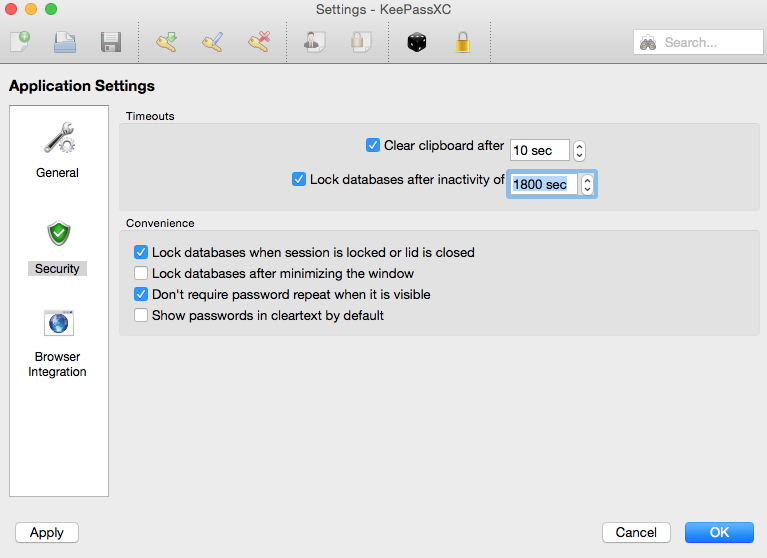

- #Keepassxc extension install
- #Keepassxc extension Patch
- #Keepassxc extension download
Create a file _browser.json in there, and paste in the following content:.Actually, the native-messaging-hosts likely does not exist yet, so do create it. Go to ~/.var/app//.mozilla/native-messaging-hosts.Now we need to tell Firefox about the new binary.
#Keepassxc extension download
So if you are in a risky mood, you can just download my keepassxc-proxy binary here. rustc_info.json).Īnd altghough Rust is not (yet) totally reproducibly compiling I did got the same bit-by-bit result on two machines with Fedora 32. The keepassxc-proxy binary, version 211ae91, compiled with rustc 1.43.0 (the current stable in Fedora 32) for x86_64 (and if it helps and you wanna know more that.
Clone the git repo and compile it (run cargo build -release). If you trust me, you can get my compiled binary below, just skip to two steps ahead. So I chose the Rust proxy application (because why should not I? 🙃). Good for us: it has not many depenencies and is available as a stand-alone application. Worst things first: We need the keepassxc-proxy as a binary, because we want to have it run inside of the Firefox flatpak. Tested with: Fedora 32, v75 from flathub, v2.5.4 from flathub Starting keepassxc-proxy by Firefox Exposing the UNUX socket from the KeePassXC flatpak to other applications outside of the Flatpak. Note: At that step, you can already run the variation: Firefox (sandboxed), KeePassXC (host-installed) Allowing Firefox to access the socket of KeePassXC. Starting keepassxc-proxy by Firefox (solution: we run it inside the Firefox sandbox). To spoiler, this are the main points we need to solve: However, even if we've solved the fact of Firefox having to run the proxy, there are more problems. So glad news ahead: This solution preserves all sandboxes and security aspects! #Keepassxc extension install
After all, from a security POV you could then also just install Firefox on the host, yet again. However, seeing how lovely and quite securley the Firefox sandbox is already built, I would not dare to destroy that security for such a feature. So we could solve that by making wrapper scripts and using flatpak-spawn to let Firefox escape it's sandbox. Anyway, whatever it does, it cannot do one thing: Spawn a process on the host or in another flatpak.

it does not have any generic access to the file system (it uses portals). Now why it does not work if Firefox is installed as a flatpak: The very good official Firefox flatpak by Mozilla really does have few permissions for being a browser.That is, so far, why Firefox installed on the host does work….
#Keepassxc extension Patch
Flathub KeePassXC has a patch that allows the keepassxc-proxy to be started via flatpak run, i.e. The only thing it possibly needs to do is get into the KeePassXC flatpak. If Firefox is not sandboxed, that proxy can start as usual. KeePassXC-Browser) and tries to listen on that socket to find messages. keepassxc-proxy is started – via native messaging – by the browser (triggered by the add-on i.e. KeePassXC creates an UNIX socket in $XDG_RUNTIME_DIR/kpxc_server for applications to listen too. But for the curious, I'll explain the problems we face: That’s it, now you would be able to autofill passwords from KeePass in Microsoft Edge browser in Linux.If you just want the solution, you can skip this part. 
If all goes well, you would be able to see a screen similar to the one shown below. In the above path, replace “ ar” with your user id and “ microsoft-edge-dev” with “ microsoft-edge-beta“, if you are using the beta version of the browser.Īs a next step, click the plugin icon in the browser and create a connection between the browser and KeePassXC application. In my machine ( Kubuntu), the path is “ /home/ar/.config/microsoft-edge-dev/NativeMessagingHosts/“.
Select “Chromium” as browser type in the Config Location, provide the config path for Edge. Navigate to the “Advanced” tab of “Browser Integration” and select “Use a custom browser configuration location:”. Select the “Browser Integration” side menu and ensure that “Chromium” is selected in the “General” tab. Open the KeePassXC application and navigate to the settings page. If you haven’t downloaded the plugin yet, you can download it from the Edge Add-Ons site Configuration Steps







 0 kommentar(er)
0 kommentar(er)
